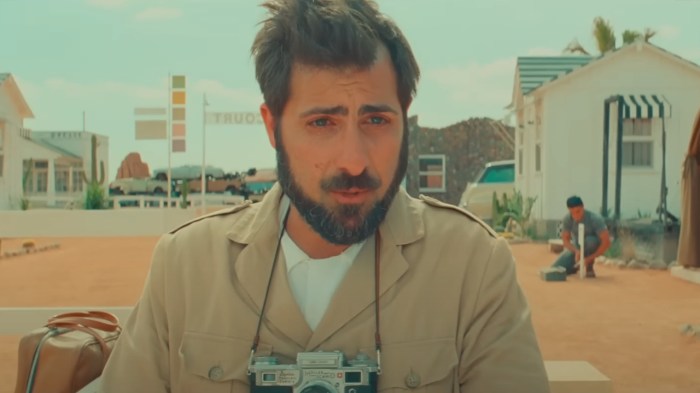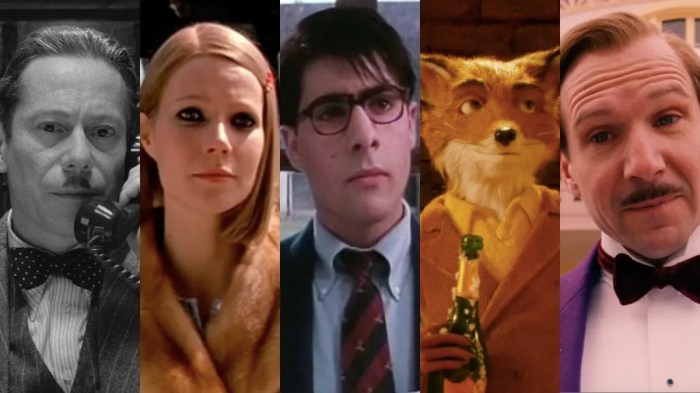Wes Anderson movies ranked: A journey through the meticulously crafted worlds of a unique cinematic voice. This exploration delves into the visual artistry, thematic depth, and narrative structure that define Anderson’s films, ultimately leading to a personal ranking of his best works.
We’ll analyze the recurring motifs, like symmetrical compositions and quirky characters, that give each film its distinct personality. Then, we’ll establish clear criteria for ranking, considering factors like visual storytelling, emotional resonance, and the director’s signature humor. The process will weigh personal preference alongside critical acclaim, leading to a thoughtful, and hopefully, insightful ranking.
Introduction to Wes Anderson’s Films

Wes Anderson’s films are instantly recognizable for their distinct visual and thematic style, a signature aesthetic that has captivated audiences worldwide. His meticulous attention to detail, quirky characters, and vibrant color palettes create a unique cinematic universe, often tinged with a whimsical yet melancholic tone. The films often explore themes of family, societal expectations, and the passage of time, all within meticulously crafted narratives that invite viewers into a world of elaborate settings and poignant storytelling.Anderson’s films are more than just entertaining; they are visual poems that linger in the mind long after the credits roll.
His unique approach to filmmaking, encompassing everything from meticulously planned shots to meticulously composed character arcs, allows for a layered viewing experience, inviting viewers to appreciate the subtle details and hidden meanings within each frame.
Just finished revisiting my Wes Anderson movie rankings, and it got me thinking about unexpected connections. While pondering the quirky charm of “The Grand Budapest Hotel,” I stumbled upon the news that Nicole Scherzinger won her first Tony Award! Nicole Scherzinger wins first Tony – a fascinating juxtaposition, right? Back to the films, though – I’m still firmly convinced “Moonrise Kingdom” deserves the top spot on any Wes Anderson list.
Recurring Motifs and Visual Cues
Anderson’s films are defined by a set of recurring motifs and visual cues that act as a visual signature. These elements contribute significantly to the overall aesthetic and thematic experience of his films.
- Symmetry and Composition: Anderson’s films are characterized by a meticulous symmetry in framing and composition. Scenes are often meticulously balanced, with characters and objects positioned in a way that creates a sense of order and visual harmony. This symmetry is not always perfect, but it’s a deliberate choice that underscores the underlying themes of balance and harmony in the face of life’s complexities.
For example, in
-The Royal Tenenbaums*, the carefully arranged furniture and architecture of the Tenenbaum family home mirror the dysfunctional relationships within the family. This visual pattern emphasizes the conflict between order and chaos. - Color Palettes: Vibrant and saturated color palettes are a hallmark of Anderson’s films. The use of specific colors, often in a contrasting fashion, can create a distinct mood and atmosphere. The bright and saturated colors in
-The Grand Budapest Hotel*, for instance, evoke a sense of elegance and nostalgia, while the muted colors in
-Moonrise Kingdom* suggest a sense of longing and isolation.I’ve been diving deep into Wes Anderson movies lately, trying to rank them. It’s tough, they’re all so unique! But while I’m pondering the perfect order, I can’t help but think about the recent LA protests, specifically the best photos capturing the energy and emotions of the moment. Seeing those images really made me reflect on how art, in all its forms, can powerfully capture a moment in time.
Perhaps a similar visual lens can help me finally nail down my Wes Anderson movie rankings. la protests trump best photos Definitely a powerful collection. Back to the movies, though!
This use of color is not arbitrary; it serves to reinforce the emotional tone of the film.
- Props and Settings: The carefully chosen props and settings are integral to the visual style of Anderson’s films. From the meticulously detailed sets to the uniquely designed props, every element is a deliberate choice, enhancing the narrative and character development. The quirky and whimsical design of the hotel in
-The Grand Budapest Hotel* reflects the quirky personalities of the characters and the absurdity of the situations they face.This meticulous design of props and sets becomes a visual metaphor for the emotional and social landscape of the film.
Impact on Viewing Experience, Wes anderson movies ranked
Anderson’s unique aesthetic has a profound impact on the viewing experience. The meticulous attention to detail, the use of vibrant colors, and the carefully composed shots create a world that is both visually stimulating and emotionally engaging. The viewer is not just passively observing the action; they are actively participating in the creation of the film’s atmosphere. This active engagement is key to the film’s impact.
Ranking Wes Anderson movies is always a tough one, isn’t it? While I’m currently obsessed with the meticulous detail and charming visuals in his films, recent news about the Trump-Newsom national guard deployment in California during the LA protests, and the ensuing legal challenge, here’s a link to a great article has got me thinking about the societal context surrounding even the most aesthetically pleasing films.
Ultimately, though, I’m still trying to decide if “Moonrise Kingdom” or “The Grand Budapest Hotel” tops my list.
Themes in Wes Anderson’s Films
Common themes that recur throughout Anderson’s filmography include:
- Family Dynamics: Family relationships, whether dysfunctional or loving, are a recurring theme. The complexities and challenges of family bonds are often explored in his films, using visual metaphors to explore the dynamics and issues. For example,
-The Royal Tenenbaums* depicts a family fractured by ambition and resentment, while
-Moonrise Kingdom* examines the longing and bonds of childhood friendships. - Societal Norms and Expectations: Anderson’s films often critique societal norms and expectations, juxtaposing the ordinary with the extraordinary. The films depict characters who are often outsiders or those who struggle to fit into societal expectations, highlighting the absurdities of social structures.
- Memory and Nostalgia: Memory and nostalgia are recurring themes in Anderson’s work. The films often explore how memories shape the present and how the past is often viewed through a rose-tinted lens, often contrasting idealized memories with the harsh realities of the present.
Character Development and Narrative Structure
Anderson’s approach to character development is often eccentric and unique, characterized by both quirky personalities and nuanced emotional depths. Characters are often defined by their relationships with each other and their unique perspectives on the world. The narrative structure is typically carefully planned and follows a particular pattern, often with a blend of humor and melancholic moments.
Ranking Criteria and Methodology: Wes Anderson Movies Ranked
Wes Anderson’s films are celebrated for their unique visual style, quirky characters, and often whimsical narratives. Deconstructing the elements that contribute to their enduring appeal, and subsequently ranking them, requires a nuanced approach. A rigid, single metric simply won’t capture the multifaceted nature of his artistic vision. Instead, a comprehensive evaluation, considering various factors, will provide a more insightful perspective.This approach acknowledges the inherent subjectivity of artistic appreciation.
While objective measures like critical reception and box office success can offer a starting point, a truly comprehensive ranking must incorporate a broader understanding of the films’ individual strengths. The ranking process will ultimately serve as a guide, not a definitive statement of universal truth.
Ranking Criteria
Understanding Wes Anderson’s distinct aesthetic requires careful consideration of multiple interwoven elements. These elements, while sometimes seemingly disparate, contribute to the unique cinematic experience.
- Originality and Visual Storytelling: Anderson’s distinctive visual language is a defining feature. This includes his signature use of symmetrical compositions, vibrant color palettes, and meticulously crafted sets. The films’ ability to communicate narrative through visuals, often bypassing dialogue, is crucial. Examples include the meticulous detail in The Royal Tenenbaums, the fantastical world of Fantastic Mr. Fox, or the quirky, yet compelling visual imagery in Moonrise Kingdom.
- Character Development and Emotional Depth: While Anderson’s characters are often eccentric and even surreal, they still evoke genuine emotional responses. The depth of characterization, despite the unconventional nature of the portrayals, is an important factor. This includes the nuance and complexity of the characters’ motivations, even in seemingly simple plots. For instance, the flawed, yet ultimately endearing characters in The Grand Budapest Hotel, or the poignant journey of self-discovery in Rushmore.
- Humor and Wit: Anderson’s humor is often dry, ironic, and understated, requiring an active engagement from the viewer. This aspect, combined with the overall tone and delivery, contributes significantly to the film’s overall impact. This can be seen in the deadpan humor of The Darjeeling Limited or the playful wit of Isle of Dogs.
- Narrative Structure and Pacing: The deliberate pacing and structure of Anderson’s films often deviate from conventional storytelling. This intentional choice can be either a strength or a weakness, depending on the viewer’s appreciation of the artistic approach. The measured storytelling in Fantastic Mr. Fox stands in contrast to the more rapid-fire narrative in Asteroid City.
- Overall Artistic Vision: This encompasses the film’s coherence and integration of all its elements. The overarching theme, tone, and consistency in style and execution are important. For instance, the thematic unity and stylistic consistency in The Royal Tenenbaums showcase this criterion.
Ranking Methodology
Various approaches to ranking can be adopted, each with its own strengths and limitations.
- Personal Preference: This approach relies on individual taste and emotional response to the films. This method, while subjective, can highlight aspects of the films that resonate deeply with the individual viewer. This is the most personal method.
- Critical Reception: This method considers the opinions of film critics and scholars, often reflected in critical reviews and awards. This approach can provide a broader perspective on the films’ strengths and weaknesses. However, individual critic preferences can introduce biases.
- Fan Consensus: This methodology considers the opinions of a large number of Anderson fans. Online forums, polls, and social media discussions can provide a valuable indication of popular opinions and shared experiences. The inherent diversity in fan tastes can still impact this approach.
Evaluating Relative Strengths
A systematic process for evaluating relative strengths is necessary to mitigate biases. This involves assigning scores to each film based on the pre-determined criteria. For instance, a film scoring highly in originality might receive a higher score than one lacking in this aspect. The overall score is a composite of the scores across all the categories.
Complexity of Subjective Art Forms
Ranking subjective art forms like film is inherently complex. There’s no single correct answer, and individual preferences will inevitably influence the outcome. This is further complicated by the fact that artistic merit can be perceived differently across cultures and generations. Ultimately, the ranking serves as a personal exploration of Wes Anderson’s films.
Closing Summary

Ultimately, ranking Wes Anderson’s films is a deeply personal and subjective endeavor. This exploration, however, aims to illuminate the nuances of his distinctive style and provide a framework for understanding the reasons behind his enduring appeal. The ranking, while presented as a personal take, is informed by the director’s evolving vision, the critical reception, and the consistent fan enthusiasm.
Hopefully, this analysis has provided a comprehensive understanding of why these films are so unique and treasured by many.

